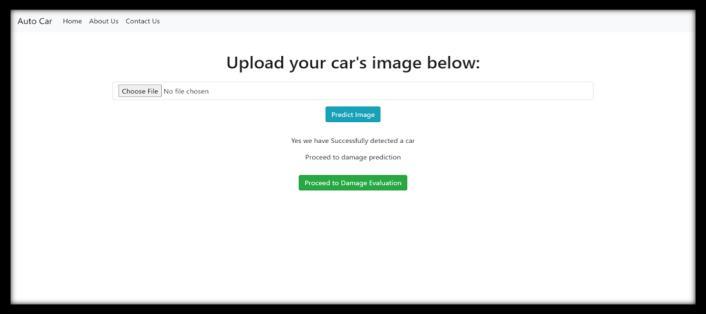International Research Journal of Engineering and Technology (IRJET) e-ISSN: 2395-0056

Volume: 10 Issue: 01 | Jan 2023 www.irjet.net p-ISSN: 2395-0072

International Research Journal of Engineering and Technology (IRJET) e-ISSN: 2395-0056

Volume: 10 Issue: 01 | Jan 2023 www.irjet.net p-ISSN: 2395-0072
Dept. of Information Technology, AISSMS’s Institute of Information Technology, Pune-1, Maharashtra, India ***
Abstract - Auto insurance processing using images is a critical industry with a lot of room for automation. In this study, we will look at the topic of car damage detection. Vehicle damage detection. Using pictures taken at thescene of an accident can save time and money when filing insurance claims, as well as provide more convenience to drivers. Artificial intelligence (AI) in the senseofmachinelearningand deep learning algorithms can help solve problems. A transfer learning-based vehicle damage detection technique and a regional convolutional neural network(MaskRCNN)mask are used to quickly solve accident compensation problems. Algorithms identify the damaged part of the car, determine its location, and then estimate the severity of the damage. Very satisfactory results were obtained using transfer learning using available models that were trained for the moregeneral challenge of object identification.
Key Words: Car Damage Detection, Machine learning, Prediction, VGG16, Transfer Learning, Deep Learning, Price Prediction
Today, one of the first businesses to invest in innovation, cutting-edgetechnology,andartificialintelligence(AI)isthe insuranceindustry.Carinsurancecompaniesspendmillions of dollars each year due to evasion of insurance claims in today'ssocietywherethenumberofcaraccidentsisonthe rise.. In the insurance industry, Artificial intelligence (AI) basedonmachinelearninganddeeplearningcanassistwith challenges including data analysis and processing, fraud detection,riskreduction,andclaimautomation.Asaresult, insurancecompanieshavesoughttoreducethetimeittakes toanalyzedamageandsettleclaims.However,developing current applications to solve these problems remains difficult,especiallywhenusingdeeplearningtoassesscar damage. Deep learning is an effective method for tackling complicatedproblems,butitnecessitatesmoreresourcesfor modelbuilding,i.e.,deeplearningdemandsalargedataset andtakeslongertocompute.Therearenopubliclyavailable datasets for automobile damaged photos because car damageassessmentisaspecializedtopic.Thehardestpartof trainingamodelisdoingitwithasmalldataset.However,in thisinstanceweusea datasetformatcalledCOCO format. UsingaMaskRCNNalgorithmonasmallCOCOdatasethas alsoshownpreciseresults.Detectron2whichisoneofthe open-source python library from Facebook provide pretrained model has been used. The Mask RCNN method is
5
usedinthepapertodetectandsegmentdamagedareasof cars. It has a lot of research value and a lot of application scenariosinthetransportationarea.Duetothecomplexity of automatic damage detection and segmentation, issues such as reduced segmentation and lower detection speed exist.TheMaskRCNNisappliedtothefieldofthisresearch, and a model for detecting and segmenting a vehicle's damaged region in an accident is proposed. Insurance companies can also use this model to quickly process insuranceclaims.
Imagesize- Thesecurityof theapplication dependsupon thesizeoftheimage.Ifweuseimagesofsmallsizethenthe optionsforselectingthepixelsisless,thisreducesthetime requiredtodecipherthekeyfromtheimage.Thenumberof pixels in an image with height h and width w is w*h. The intruder or attacker has to check all the combinations of choosingthepixelsfromtheimagetodecipherthekeyfrom the image. By increasing the size of the image, we can increasethesecurityoftheapplication.
A previous study [1] has used pre-trained deep learning models,MobileNet and YOLO,and have beenapplied ona customizedvehicledamagedataset.YOLOalgorithmisused for detection but YOLO’s full utilization is in classifying multipleobjects.Inthiscase,onlyasingleobjecti.e.caristo bedetectedwhereVGG-16canbeused.
AnotherstudybyUmerWaqas,NimraAkram,SoohwaKim, Donghun Lee, Jihoon Jeon [2] uses algorithm to classifies three types of vehicle damage categories which include mediumdamage,hugedamageornodamage.Also,metadata analysis and moiré effect detection is used to verify the authenticityoftheimagesuploadedbyusers.
In[3],aninsighttofurthermoreimprovementissuggested. RobustMaskRCNNalgorithmisutilizedwhichimproveson previousworkyetisstilllackinginfewareas.Forexample, thedetectionaccuracyisveryhigh,butthemask instance segmentationcannotbecompletelycorrect,andsomeareas inwhichthedamageisnotobviouscannotbesegmented.
Anotherpaper[4]proposesadeeplearning-basedsolution for car damage classification. Since there was no publicly availabledataset,theycreateda newdatasetbycollecting
International Research Journal of Engineering and Technology (IRJET) e-ISSN: 2395-0056
Volume: 10 Issue: 01 | Jan 2023 www.irjet.net p-ISSN: 2395-0072
images from web and manually annotating them. Experimentedwithmultipledeeplearning-basedtechniques such as training CNNs from random initialization, Convolution Autoencoder based pre-training followed by supervisedfinetuningandtransferlearning.

The different steps which will be carried out in order to create and use different classifiers and get most probable results.Outofthedifferentresultsandaccuraciesproduced by different Machine Learning models, we will utilize the bestmodelwiththebestaccuracyforCardamagedetection and price prediction. System Architecture will give us an overviewoftheworkingofthesystem.

5.1.SystemArchitecture
A heatmap is a two-dimensional visual representation of datawherevaluesarecolor-coded,providingaconvenient andinsightfulviewofinformation.
Module-5:
Dependingonthedamage,thelocationofthedamageand themodelofthecar,thecostofrepairingthedamagewillbe predicted.
The below figure 2, represents the Data Flow Diagram of proposedsystem.Thecustomer/useruploadstheimageof car.Thenthatimageisprocessedandthereportofdamage isgeneratedanditissentbacktotheuser.
Fig.1:CarDamageDetectionArchitecture
WebApp:
Here users can upload images of the damaged car or any random images which will be processed by our algorithm usingtheGUIwhichiscreatedusingHTML,CSS,Bootstrap andintegratedbyflask.
Module-1:
In this module, VGG-16 is used to detect whether the uploadedimageisacarornot..
Module-2:
Here, car damage is detected using VGG-16, VGG-19 and ResNet-50. The model that gives us the most accuracy is considered..
Module-3:
Thesideofthevehiclewherethedamagedisincurredi.e.In therearpart,frontpartorsidepartisidentifiedusingthis module.
Module-4:
Thedamagelevelisfurtherdecidedinthismodule.Thelevel ofdamageisdecidedbydatavisualizationusingheatmaps.
Fig-

Here,thefirstmoduledetectswhethertheuploadedimageis ofcarornot.Ifthecarisnotdetectedthenitreturnsbackto theinitialstage.Andifcarisdetectedthenfurthermodules takeplace.Thenextmoduledetectswhethertheuploaded imageofcarhasdamageornot.Ifthedamageisnotdetected then it returns back to initial stage. Once the damage is detected,furthermodulesdetectslocation(front,side,back) andseverity(minor,moderate,major).Abovemoduleswill helpinpredictingtheprice.
2022, IRJET | Impact Factor value: 7.529 | ISO 9001:2008 Certified Journal |

International Research Journal of Engineering and Technology (IRJET) e-ISSN: 2395-0056

Volume: 10 Issue: 01 | Jan 2023 www.irjet.net p-ISSN: 2395-0072
UserInterfacehasbeendeveloped.
Also the first module which detects the car has been integratedusingflask.
Fig5showsthattheuploadedimageisofcar.
Oncethecarisdetected,itwilldirectusertonextstepi.e. DamageEvaluation.
Fig- 6: Carnotdetected
Abovefig6showswhentheuploadedimageisnotofcar.
Fig- 3: HomePage
Homepageprovidesbasicinterfacewiththeoptionshowing UploadImage.
Ifthecarisnotdetectedthenuserisrecommendedtoretake photoandthenuploadagain.
KERAS:APythoninterfaceforartificialneuralnetworksis provided by the open-source software package known as Keras. The TensorFlow library interface is provided by Keras.
TensorFlow:TensorFlowisanopen-source,freemachine learningandartificialintelligencesoftwarelibrary.Although deep neural network training and inference are given specificattention,itcanbeusedforavarietyoftasks.
After clicking on Upload Image on Home Page, option is giventouploadimageandpredictthatimageisofcarornot. Here,thedataofthefirstmodulewhichdetectswhetherthe uploadedimageisofcarornotisintegrated.




ThefirstmoduleistrainedusingVGG-16.
VGG-16 and VGG-19: VGG stands for Visual Geometry Group;itisastandarddeepConvolutionalNeuralNetwork (CNN)architecturewithmultiplelayers.VGG-16andVGG-19 consistingof16and19convolutionallayersrespectively.
ResNet-50: ItisaConvolutionalNeuralNetwork(CNN)that is50layersdeep.Here,wecanloadapretrainedversionof thenetworktrainedonmorethanamillionimagesfromthe ImageNetdatabase
Fig-5: CarDetected
Todealwiththecompensatingproblemofdamagedautos, the model proposed here employs, a deep learning-based detectiontechniqueforvehicle-damageidentification.The suggested approach of transfer learning-based damage detectionofthevehicleisgenericaftertesting,andcanalso betteradapttothediverseelementsofdamagedcarimages. Despite the model's training on a very short dataset, successfuloutcomeswereobtained.Dataextensioncanbe done in the future to raise the dataset's size, gather additionalautomobiledamageimagesundervariousdegrees ofilluminationandweatherconditions,enrichthedata,the
International Research Journal of Engineering and Technology (IRJET) e-ISSN: 2395-0056

edgecontourenhancementofimagescanbeimprovedand thedamagedpartsofthecarcanbemaskedmoreaccurately. Also,themodelcanbefurtherenhancedtopredicttherepair priceofthedamagedareabyextractingthepredictedpart detailslikethesegmentedmaskarea.
[1] “Automated Detection of Multi-class Vehicle Exterior Damages using Deep Learning” | Maleika HeenayeMamode Khan, Mohammad Zafir Hussein Sk Heerah, Zuhairah Basgeeth | IEEE 2021 | DOI:10.1109/ICECCME52200.2021.9590927
[2] “Vehicle Damage Classification and Fraudulent Image DetectionIncludingMoiréEffectUsingDeepLearning”| UmerWaqas,NimraAkram,SoohwaKim,DonghunLee, Jihoon Jeon | 2020 IEEE Canadian Conference on ElectricalandComputerEngineering(CCECE)
[3] “Vehicle-Damage-Detection Segmentation Algorithm Based on Improved Mask RCNN” | Qinghui Zhang, XianingChang,andShanfengBian|IEEEAccess|DOI: 10.1109/ACCESS.2020.2964055
[4] “Deep Learning Based Car Damage Classification” | KalpeshPatil,MandarKulkarniy,AnandSriramanyand ShirishKarande



[5] R. S. Gaykar, V. Khanaa and S. D. Joshi, "Detection of FaultyNodesinDistributedEnvironmentusingMachine Learning," 2021 3rd International Conference on Advances in Computing, Communication Control and Networking (ICAC3N), 2021, pp. 228-232, DOI: 10.1109/ICAC3N53548.2021.9725478.
[6] R.S.Gaykar,C.NaliniandS.D.Joshi,"Identificationof StragglerNodeinDistributedEnvironmentUsingSoft ComputingAlgorithms,"2021InternationalConference onEmergingSmartComputingandInformatics(ESCI), 2021,pp.1-5,DOI:10.1109/ESCI50559.2021.9396825.

Mrs ReshmaTotare AssistantProfessorDept. ofInformation TechnologyAISSMSIOIT, Pune

VaradBhalsing BE-IT
AISSMSIOIT,Pune
MayurLende BE-IT
AISSMSIOIT,Pune
TejasMaramwar BE-IT
AISSMSIOIT,Pune
ChiragNaikwadi BE-IT
AISSMSIOIT,Pune
Volume: 10 Issue: 01 | Jan 2023 www.irjet.net p-ISSN: 2395-0072 © 2022, IRJET | Impact Factor value: 7.529 | ISO 9001:2008 Certified Journal | Page461